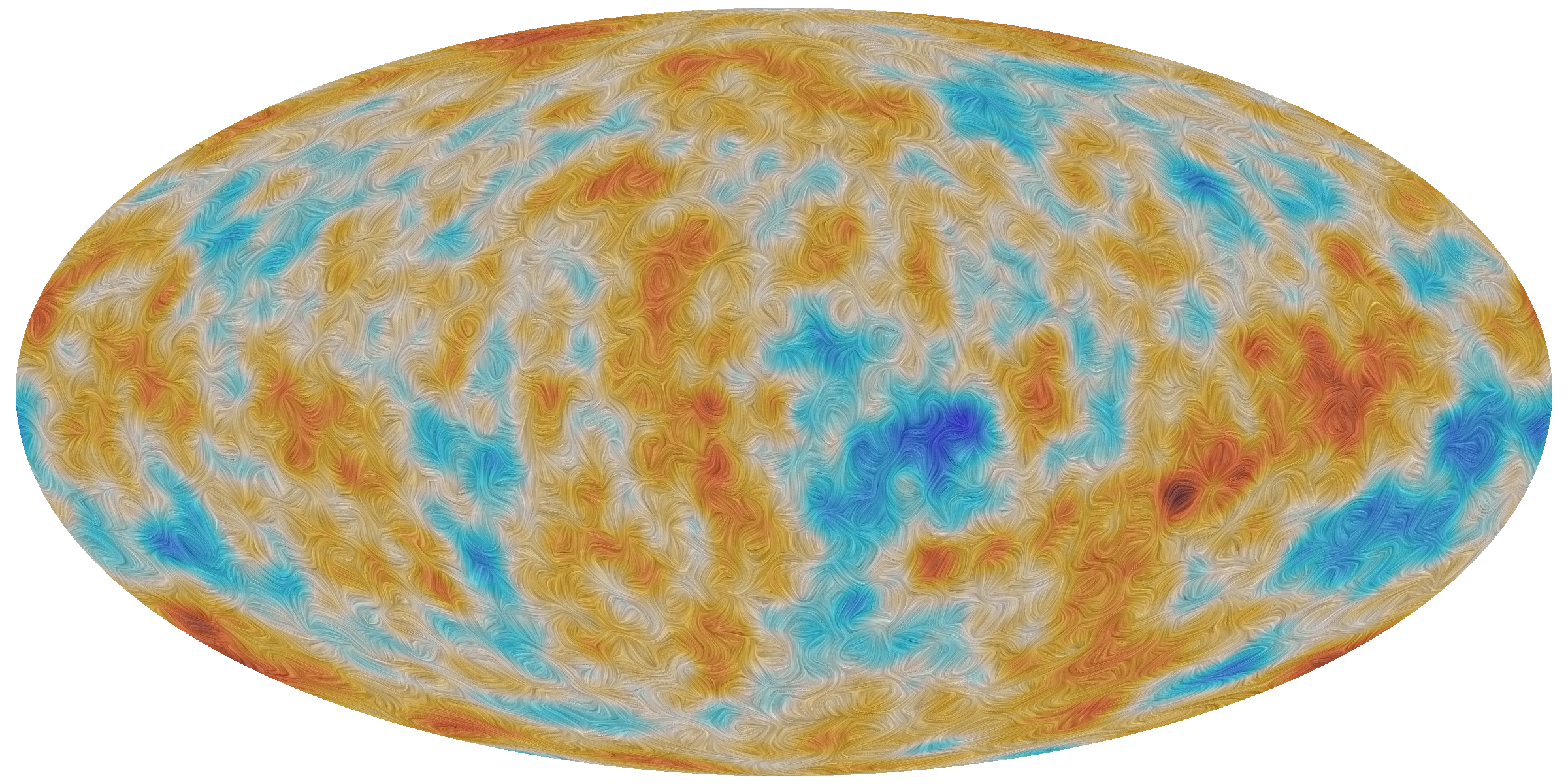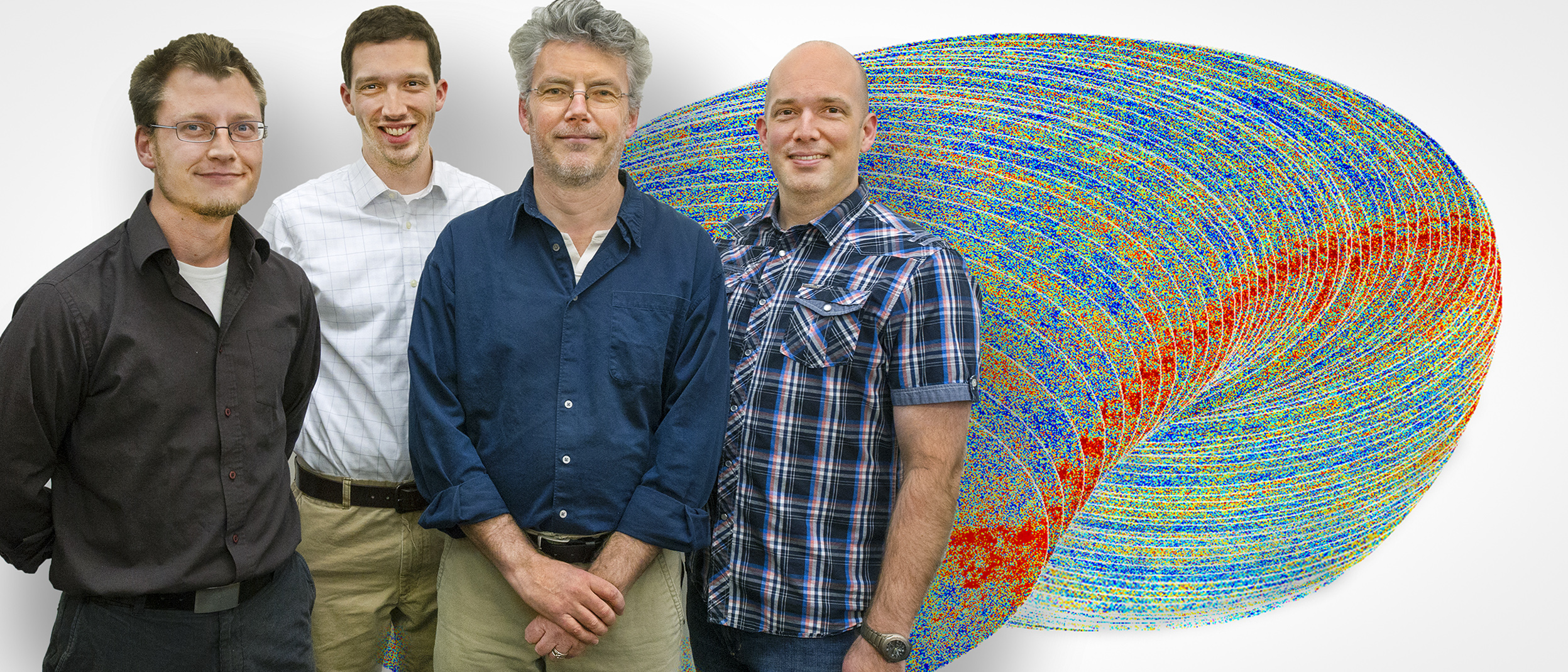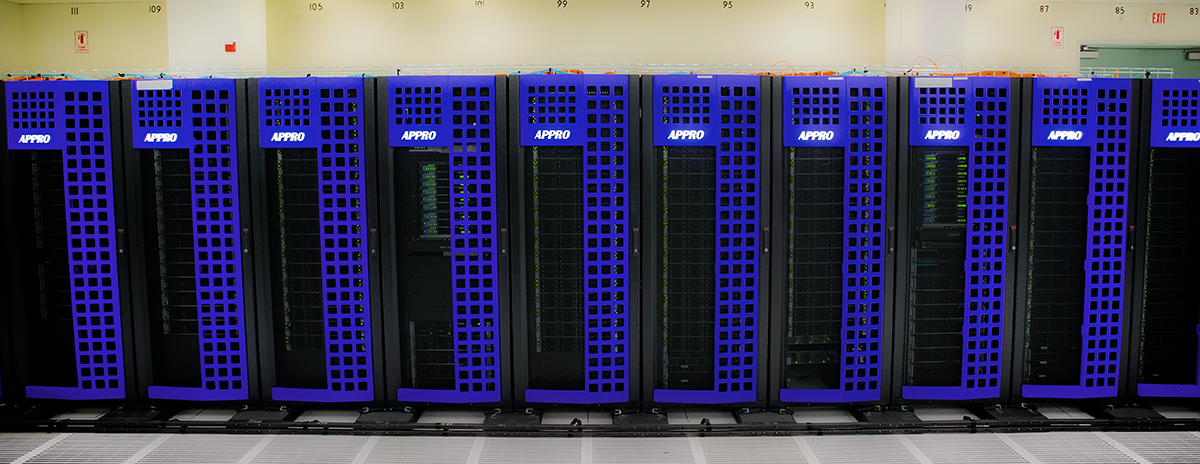
A visualization of the polarization of the cosmic microwave background, or CMB, as detected by ESA’s Planck satellite over the entire sky. A small fraction of the CMB is polarized, meaning it vibrates in a preferred direction. In this image, the color scale represents temperature differences in the CMB while the texture indicates the direction of the polarized light. (Credit: ESA and the Planck Collaboration)
The Planck Team — including researchers in the Computational Research (CRD) and Physics divisions at Lawrence Berkeley National Laboratory (Berkeley Lab) — and its Principal Investigators Nazzareno Mandolesi and Jean-Loup Puget, have been awarded the 2018 Gruber Cosmology Prize.
The Gruber International Prize Program honors individuals whose groundbreaking work in the fields of cosmology, genetics, and neuroscience provides new models that inspire and enable fundamental shifts in knowledge and culture. From 2009 to 2013, the European Space Agency’s Planck observatory collected data that has provided cosmology with the definitive description of the universe on the largest and smallest scales.
“These measurements have led to the determination of cosmological parameters (matter content, geometry, and evolution of the universe) to unprecedented precision,” the Gruber Prize citation reads.
The 2018 Cosmology Prize recipients will divide the $500,000 annual award three ways. The Planck team will receive $250,000; while Mandolesi and Puget, as the principal investigators on the observatory’s two instruments, will each receive $125,000. The Prize will be awarded on Aug. 20, at the General Assembly of the International Astronomical Union, in Vienna, Austria.
Berkeley Lab’s Deep Roots in the Planck Collaboration
Berkeley Lab played a deep role in Planck’s success, beginning with the 1992 proposal by Berkeley Lab’s George Smoot and then-visiting Italian scientists Marco Bersanelli and Mandolesi, to build a Cosmic Microwave Background (CMB) survey satellite dubbed COBRAS (Cosmic Background Radiation Anisotropy Satellite). Later combined with a complementary proposal called SAMBA (Satellite for Measurement of Background Anisotropies), COBRAS/SAMBA eventually became Planck. All three were members of the Planck team and Mandolesi served as principal investigator of the mission.
Planck was a joint project between the European Space Agency and NASA, and one of the major U.S. contributions to this international collaboration was in data analysis. For nearly two decades, Berkeley Lab’s Julian Borrill served as the U.S. Planck Team’s computational systems architect, a role that earned him a NASA Exceptional Public Achievement Medal in 2016. Other key members of the Planck team at Berkeley Lab include Theodore Kisner and Reijo Keskitalo, computer science engineers in CRD; Shirley Ho, senior scientist in the Physics Division and Cooper Siegel Associate Professor at Carnegie Mellon University; and Martin White, Berkeley Lab faculty senior scientist in the Physics Division and a professor in the Physics and Astronomy departments at UC Berkeley. Kisner and Keskitalo implemented the supercomputing framework for Planck data analysis and received numerous NASA Public Service and Group Achievement awards. White served on the Planck Editorial Board and chaired the U.S. Internal Advisory Board on Planck, and both White and Ho shared the NASA group achievement award for Planck in 2010.

The Planck analysis group with CMB Planck data images. From left to right: Reijo Keskitalo, Aaron Collier, Julian Borrill and Ted Kisner. (Credit: Roy Kaltschmidt/Berkeley Lab)
Borrill’s efforts in support of Planck have included everything from directing the development and deployment of the massively parallel software needed for Planck’s most computationally challenging data simulation and analysis tasks, to drafting the memorandum of understanding between NASA and the U.S. Department of Energy (DOE) that ensured that Planck would have access to the National Energy Research Scientific Computing Center (NERSC) throughout the mission. NERSC, located at Berkeley Lab, is the primary scientific computing facility for DOE’s Office of Science. Borrill’s work on Planck was supported by NASA and the DOE’s Office of Science through its High Energy Physics program.
“NERSC supported the entire international Planck effort,” said Borrill, who heads Berkeley Lab’s Computational Cosmology Center and has a joint appointment at UC Berkeley’s Space Sciences Laboratory. “Planck was given an unprecedented multi-year allocation of computational resources in a 2007 agreement between DOE and NASA, which amounted to tens of millions of hours of massively parallel processing, plus the necessary data-storage and data-transfer resources. These resources were mission-critical for Planck data analysis.”
“In many ways, Planck was a turning-point for cosmic microwave background research. This was the first time that we had wide-area, high-resolution, high signal to noise, multifrequency observations that allowed us to measure the basic parameters of the universe with such incredible precision,” said White.

Mendel, a Cray scientific computing cluster at NERSC named for the father of modern genetics, Gregor Johann Mendel, was used by the international Planck collaboration for data analysis. (Credit: Roy Kaltschmidt/Berkeley Lab)
He noted that Planck also opened up entire new fields of cosmology research. “As CMB photons travel from the edge of the universe to Earth, they traverse a bunch of stuff along the way — like galaxies, stars, black holes, planets, etc. — that can alter their path. By taking that pattern of deflection, we now can map out all of the matter that’s between us and CMB. Planck represented a big step forward on this front and it’s going to be a bigger and bigger part of CMB studies in the future,” White added.
“The Gruber Cosmology Prize is a fitting award in recognition of the incredible scientific achievements of Planck, and we are proud of the role Berkeley Lab has played in its success,” said Natalie Roe, director of Berkeley Lab’s Physics Division. “We are continuing to build on the scientific foundation laid by Planck as we plan the next generation of CMB experiments, seeking to fully plumb the mysteries carried to us from the early universe by this faint radiation.”
The work was supported by the DOE Office of Science’s Office of High Energy Physics. NERSC is a DOE Office of Science user facility.
More about Berkeley Lab’s Planck Contributions:
- CRD’s Julian Borrill Receives NASA’s Exceptional Public Achievement Medal
- Planck Mission Updates the Age of the Universe and What it Contains
- Building the Massive Simulation Sets Essential to Planck Results
- Planck Mission Has Roots and Branches in Berkeley
- A Rising Tide of Cosmic Data
###
Lawrence Berkeley National Laboratory addresses the world’s most urgent scientific challenges by advancing sustainable energy, protecting human health, creating new materials, and revealing the origin and fate of the universe. Founded in 1931, Berkeley Lab’s scientific expertise has been recognized with 13 Nobel prizes. The University of California manages Berkeley Lab for the DOE’s Office of Science.
DOE’s Office of Science is the single largest supporter of basic research in the physical sciences in the United States, and is working to address some of the most pressing challenges of our time. For more information, please visit science.energy.gov.

